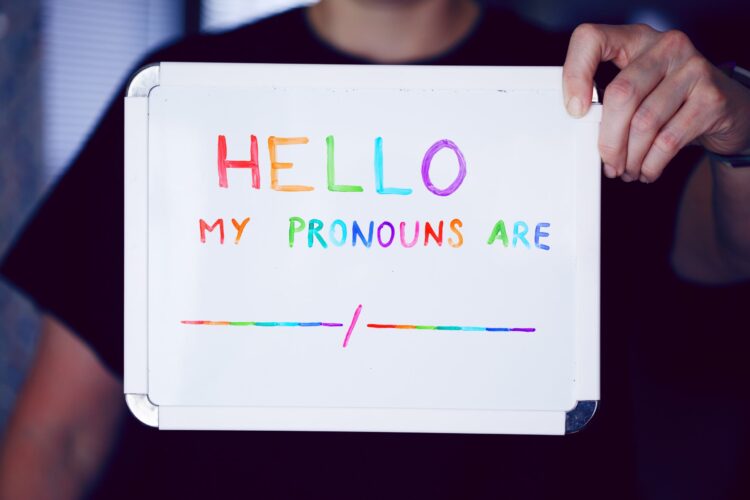When the folks at Webster-Merriam embraced the use of "they/them" as singular pronouns, the reaction from those in the writing world ranged from relief to indignation to celebration.
- Relief: No more need to torture sentences to follow grammatically correct rules with clumsy "he or she" references to an unknown individual. Example: The new editor will be announced next week. He or she will determine any further changes to newsroom staffing. Or: When a writer choses a lede, he or she is making a promise to readers. Also no nit-picky need to remember that a team, business, institution or organization is singular while its players, employees or members are plural. And this recognizes the way we talk or, as Merriam-Webster pointed out, the way people have talked — and written — since the 1300s. This is how it led a "Words We're Watching" post in 2019.
- Indignation: What about standards? This a slippery slope to "anything goes." Pretty soon we'll be putting social media acronyms in our news reports: OMG! We're doomed!!
- Celebration: As the LGBTQ+ community claims its voice in society and the press, "they/them" recognizes the right of non-binary people to self-definitions that reject rigid gendered labels.
I share all three positions — which makes me either open-minded or wishy-washy. I am mostly in favor of writing that reflects conversational conventions, and I'd love to gain back the hours of rewriting and editing that I've invested in torquing sentences that seem more about rules than common sense. As a spelling bee competitor who was taught to diagram sentences and monitor my subject-verb tense agreement, it can be disconcerting to work with students and young writers who use a shorthand that seems lazy. And I was part of the 1970s feminist movement that fought against default references to women by marital status; we brought "Ms." into accepted lexicon, and in 1980s saw the needed shift away from "homosexual" to "gay" — and then only when even that latter was relevant to a story. Bring on the language that is current, inclusive and makes sense.
As long as it's clear. Nothing excuses journalistic writing that confuses readers. And few things create greater confusion that non-specific pronouns.
So I have found myself struggling with the clarity of "they/them" in conversations and, even more, in text. And that's why I found myself impressed with a recent news story in The New York Times that managed to have it all ways. It was both inclusive and clear, and even included the preferred "they/them" as a relevant bit of information.
The story in question was about the sentencing of Anderson Lee Aldrich, who pleaded guilty to multiple murder charges in the shooting last year Club Q in Colorado Springs, Colorado. In exchange for the guilty plea, Aldrich was spared a death sentence.
This is, as noted in the paragraph above, a news story — the kind where the usual rules of journalistic writing apply. Yet the reporters, Jack Healy and Kelley Manley, sprinkled it with moments of context, description and emotion that added depth and humanity. Note especially this paragraph with the briefest of character sketches of the five people who were killed that night:
... survivors and relatives walked one by one to a microphone to share tearful memories of the people who had been killed: Daniel Aston’s “burning blue eyes.” Derrick Rump’s smile. Raymond Green Vance’s gentle spirit. How Kelly Loving wanted others to be “unapologetically ourselves,” and how Ashley Paugh’s young children begged for someone to bring their mother back.
But it's how the story deals with they/them pronouns that stands out. Here's the fourth paragraph, which follows a summary of Aldrich's plea and sentence:
The defendant, who identifies as nonbinary and uses they/them pronouns, stood on Monday in a courtroom packed with victims of the attack and relatives of the dead, and tersely answered a series of questions from Judge Michael McHenry about whether the defendant understood the terms of the plea.
Then the story goes on to challenge Aldrich's claim that this was not a hate crime targeting the gay club:
Many of the survivors and relatives referred to the defendant using male pronouns, dismissing the nonbinary identification as a sham and what one survivor’s mother called a “repugnant attempt” to win leniency. At a news conference afterward, District Attorney Michael J. Allen said there was “zero evidence” before the shooting that the shooter identified as nonbinary, and called the shooting a “terror attack based on hate.”
From there, the reporters had to deal with names and pronouns on second reference. They followed The New York Times style of using a courtesy title, in this case the new designation "Mx." Then they used "they" as a singular, which works because it immediately follows the direct and clear reference to the defendant by name:
But Mx. Aldrich offered no details about why they carried out the shooting, and little explanation beyond a bare-bones admission using legal language. They did not directly admit to committing hate crimes in targeting Club Q, and instead said they were pleading “no contest” to those charges because it was likely that they would be convicted at trial.
In one more paragraph where this could get tricky, the reporters did the smart thing and repeated Aldrich's name in the same sentence rather than rely on what could be a confusing pronoun:
In a notice of intent to file suit, the victims say that under Colorado’s red-flag laws, Mx. Aldrich’s guns should have been seized after Mx. Aldrich made a bomb threat against some relatives in 2021 and expressed an intention to become “the next mass killer.”
Language will continue to change, as it should. So, too, should our use of it in journalism. But this is a good model that demonstrates how to adapt to evolving usage without undermining clarity.



